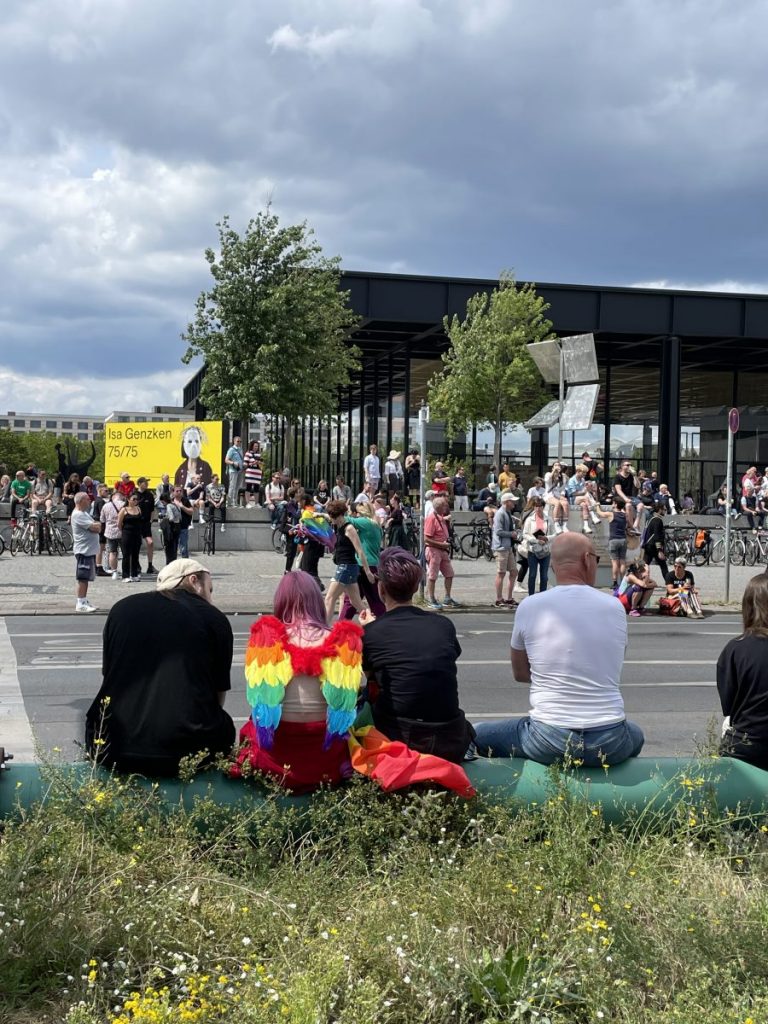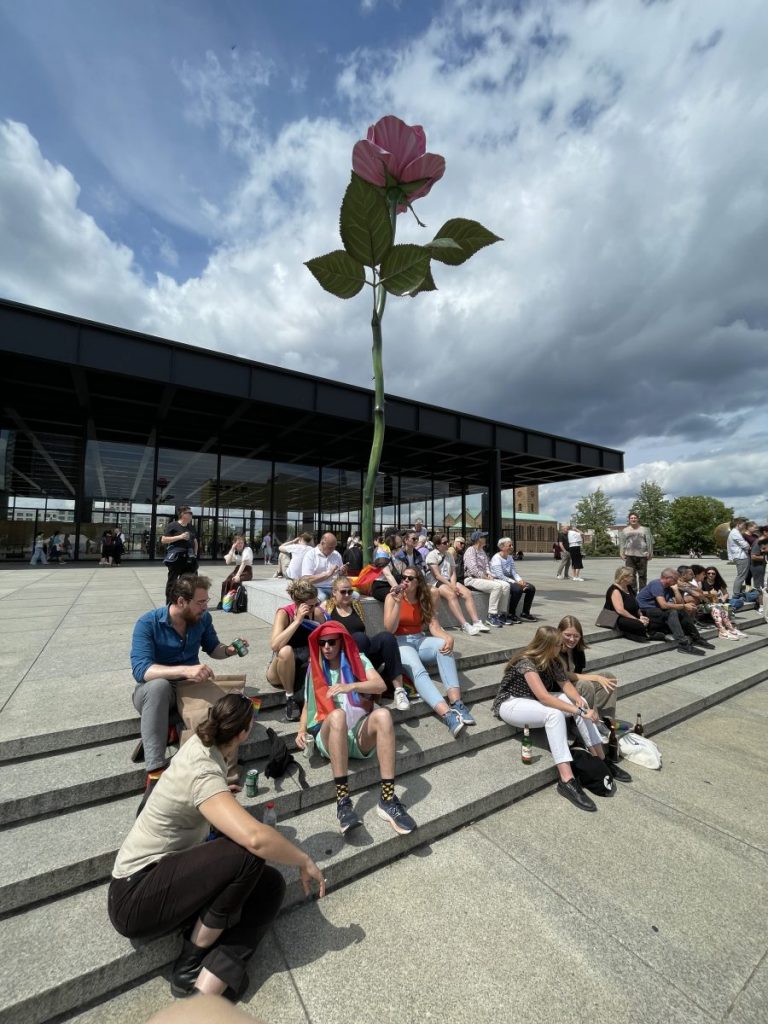Finally the influential sculptor gets her show at Neue Nationalgalerie in Berlin
Isa Genzken 75/75 at Neue Nationalgalerie is an extraordinary experience, probably the most important exhibition in Berlin this season. I went to see it on a hot Saturday afternoon in July when the CSD parade was in full swing on Potsdamer Straße. Some of the party people with rainbow colored angel wings, cropped net tops and glitter on their cheeks were taking a break on the museum steps under Genzken’s Pink Rose, a gigantic cast aluminum rose on a spiky stem. The sculpture looked like is was specially made for the occasion: a thorny tribute to love and life in all its outlandish forms. The whole museum, normally a temple for quiet art appreciation, seemed to suddenly vibrate with noisy queer activities.


Neue Nationalgalerie, Mies van der Rohe’s iconic – and slightly intimidating – glass and steel pavillon, turns out to be the perfect stage for Genzken’s sculptures. The wide open space functions like a giant walk-in diorama. You can wander freely between the works. No guard rails, partitions or protective glass keep you from getting close. It makes a huge difference because Genzken’s sculptures are modeled after a human scale. Examinating them up close opened my eyes for tiny details and hidden messages embedded in her cool concrete structures and fragile bric-a-brac assemblages.
In my life, I’ve always been concerned with fluidity and opposed to rigidity. That’s been automatic – I’ve never had to think about it.
Isa Genzken
Isa Genzken turns 75 in November. That’s why the curators (Klaus Biesenbach, Lisa Botti) chose exactly 75 works from various phases of her career. The show opens with her elegant early Ellipsoids and Hyperboloids, extremely slender wooden sculptures, six to twelve meters long which rest on the floor at only one or two points. Genzken started these works in 1976 when she was still a student at Kunstakademie Düsseldorf. The shapes are based on mathematical formulas. Working with a physicist she calculated the precise diameter and measurements using a computer. Pretty far out for artists those days. With their smooth painted surface these pieces look like mysterious, machine-made things from outer space. They are my favorites!
She started her career with the most difficult works

Genzken started her career with the most difficult, most exacting works, crafted these sculptures painstakingly by hand. She showed her macho artist peers she could do it and wasn’t too impressed by their sloppy „Neue Wilde“-paintings. The perfection of the Ellipsoids gave her the freedom to experiment, become more loose, playful, less strict in her later work. While strolling through the sun-drenched gallery you’ll encounter concrete blocks on skinny steel tables with marks and cracks on the surface. Sometimes radio antennas are sticking out of the grey masses – her „World Receivers“. Steel frames are covered in epoxy resin and look like props from a sci-fi movie. Flimsy columns wrapped in shiny fabric are decorated with CDs and Michael Jackson posters. You run into „Actors“, life-size mannequins dressed in second-hand clothes and wearing masks. Or you stumble upon a toppled wheelchair with mirror foil on its seat. And all the while you are watched over by Nofretete, the famous Egyptian queen, whose plaster bust sits on a high wooden pedestal wearing chic aviator sunglasses.
Isa Genzken’s sculptures are made to communicate, they send and receive messages









Genzken’s sculptures are made to communicate, They send and receive messages. Not only the instagram type where visitors take selfies with the hipster Nofretete. The works signal a fluidity in materials and narratives. They also reveal the artist’s keen sense for architecture and proportions. And they transmit her feelings while making them. Genzken gives herself permission to show personal emotions through her work – the most risky thing for an artist. You can sense a vibe of optimism radiating from the Ellipsoids, fragility and alienation in the assemblage columns, a feeling of liberation in the photo collages and whimsical Empire/Vampire scenes from New York. There are also signs of struggle and pain. On the outside of a shiny tower created in 2015 Genzken pasted instructions for painkiller medicine. Inside the tower I discovered a small photograph of Genzken and Gerhard Richter, her ex-husband and teacher at the Kunstakademie. When they got divorced in 1993 after ten year of marriage Genzken struggled with depression. She left for New York, away from old „Meister Gerhard“ (the title of one of her early sculptures) who found himself a new student wife. Genzken meanwhile made new works, met new artist friends, but also continued to struggle with mental health issues.
She shows emotions through her work – a risky thing for an artist

Despite all her troubles, she has become a major artist of considerable influence. She had big museum exhibitions, including a retrospective at MoMA in 2013. Her work was featured prominently in international shows such as documenta (3x) and Venice Biennale (5x), where she represented Germany in 2007. So she really made it. Nevertheless, the Berlin exhibition is something special. Neue Nationalgalerie happens to be the place where German artists are crowned. Richter had his big retrospective there, Jörg Immendorff, Thomas Demand… but very few women so far. That’s why it feels so exhilarating to walk through Genzken’s laid-back, loosely arranged sculpture parcours. Her work is both grand and messy, whimsical and triumphant, the cheeky celebration of a brilliant, funny, complicated mind. While her ex’s paintings are lined up orderly in the basement gallery, upstairs Isa Genzken’s sculptures are having a raving party in the sunlight.
